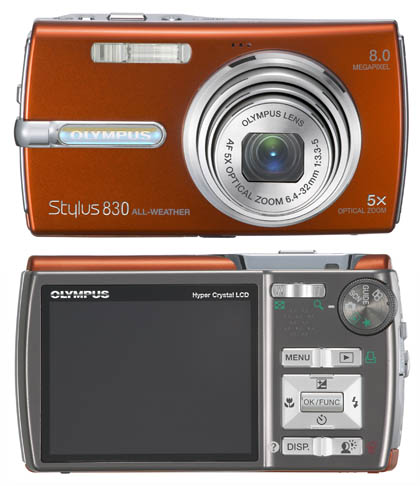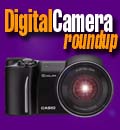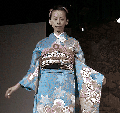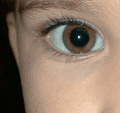|
Olympus Stylus 830
Long zoom and sensor-shift image stabilization
(by Conrad H. Blickenstorfer)
The Stylus 830 is an interesting member of the lineup of design and performance oriented cameras Olympus introduced in the Summer of 2007. The Stylus series has always emphasized design and performance in slender, attractive packages. Olympus always makes sure that Stylus models differentiate themselves from the somewhat less expensive "Easy & Fun" FE series cameras. This year the primary extra attraction is a longer 5X optical zoom. That is certainly welcome. A bigger task, perhaps, was to differentiate the various Stylus models enough to give each its own separate niche.

Those who spend the time to analyze and compare new models (like us guys here at DigitalCameraRoundup.com) will notice a somewhat peculiar situation: The Stylus 830 seems almost identical, yet it costs $329 versus just $249 for the Stylus 820, and it's priced within $20 of the new Stylus 1200 with its massive 12-megapixel resolution. What gives? Why so expensive?
Well, photo geeks and nerds (um... that would again be us here at DigitalCameraRoundup.com) may remember a similar situation last year where the virtually identical Stylus 740 and 750 were also prices very differently without as much as revealing even on their box why a consumer should pay that much more.
Here's why you pay more for the Stylus 830
The reason why you pay a good bunch extra for the 830 is dual image stabilization technology, plain and simple. Dual image stabilization technology combines digital image stabilization with mechanical sensor shift image stablization, making for a much more powerwful and sophisticated anti-blur solution. So while digital image stabilization simply boosts sensitivity and uses a shorter shutter opening, mechanical sensor-shift stabilization actually compensates for camera movement at the CCD image sensor level. Does it work? We haven't had a chance to directly compare the Stylus 820 and 830, but we extensively compared last year's 740 and 750. The 750 consistently shot clearer images, especially when zooming in. And with the 830 now having a 5X optical zoom, this is more important than ever.
Is there anything else to justify the much higher cost? Nope. In fact, in several areas you actually get less than with the Stylus 820. The 830's display measures 2.5 inches diagonally instead of the 2.7 inches on the 820. It only has a meager 15MB of onboard memory instead of 48MB. Its maximum sensitivity is ISSO 1600 instead of ISO 3200.
There is, however, one thing that can clinch the deal: underwater shooting. Unlike the 820, the 830 does have underwater modes though we haven't seen a corresponding optional underwater housing on the Olympus website yet. Still, giving underwater modes to the camera that has dual image stabilization makes a whole lot of sense. Last year, while the Stylus 750 did fit into the 740's underwater case, ironically, its "anti-shake" button was the only hardware control not accessible once it was inside the PT-034 underwater case, so you had to remember to set the camera into that mode before you closed the housing.
What you get with the Stylus 830
Available in silver, black, blue, green and orange, the Stylus 830 is an elegant 8-megapixel camera with a nice, long 5X optical zoom. Its footprint of 3.9 x 2.2 is small enough, but really not smaller than some of the FE series cameras, and the 830 is almost an inch thick, leaving it in the ultra-compact, but not the ultra-thin, class. It weighs 4.4 ounces without its Li-Ion battery. Still, considering the 36-180mm equivalent 5X optical zoom, the camera's size is more than acceptable. You know it's there, but it still fits into almost any pocket or purse. Theere is also an above average 5.6X digital zoom so that Stylus 830 owners can shoot at a maximum combined magnification of 28X.
With most digital cameras not having an optical viewfinder anymore, having a bright, easily viewable LCD is imperative. Though not as large as the 820's 2.7-inch display, the 830's 2.5-inch HyperCrystal LCD with 230k pixel resolution is large and sharp enough for comfortable image review and making sure than pictures are truly in focus. There is also a 5-step brightness adjustment that offers far better viewing optimization than any FE series camera. Finally, the LCD has a viewing angle of almost 180 degrees, so photos can be composed from a range of angles and the subject still remains visible.
Nice features
With almost all digital cameras now offering more than enough resolution, distinguishing features are becoming more and more important. Here are some of the goodies Olympus offers:
Like several new Olympus models, the Stylus 830 has a face detection mode. This means that the camera is able to find a face or even multiple faces in a picture and make sure that they are in focus and properly exposed. That even works when people are moving (though not quite as well).
Like all Stylus cameras, the 830 offers "weatherproof engineering," i.e. a degree of protection via a light-weight metal body with rubber gaskets throughout the interior when it is used in the rain, at the beach, while skiing or in other situation where the camera is likely to get wet or exposed. And Olympus certainly knows a thing or two about weatherproofing; its waterproof Stylus 770 can withstand 33 feet of water pressure and more. Further, with the 830 having underwater modes and thus an optional underwater case, it is nice to know that a bit of splashing won't destroy the camera.
The TruePic III Image Processor, developed for digital SLRs, delivers more vibrant colors, smoother edges, less nosie and higher overall speed.
The Stylus 830 also has new in-camera panoramic photo shooting feature that captures three images and stitches them together into one panoramic picture. You just press the shutter and slowly pan across a panoramic scene. The second and third images will be automatically captured and stitched together with the first image. You can, of course, do that in imaging software such as the included Olympus Master 2 that stitches up to 10 pictures together.
The camera itself
Like the Stylus 820, the 830 is handy and easy to use right out of the box. Digital camera controls, once wildly different from brand to brand, have largely become standardized, and so it's fairly easy to find your way around. There seems to be an ongoing debate among manufacturers whether it's better to have mode wheels or onscreen menus to put the camera into its various shooting modes. Each approach has its advantages, but there are some basic truths. For example, if you're shooting in bright daylight, LCD screens can still wash out or reflect so much that you just can't see a thing. That's when on-screen-only menus can let you down. Mode wheels, on the other hand, offer no problems in sunlight (though they can at night) can quickly get cluttered when they're loaded up with too many tiny icons. So for now Olympus seems to favor a hybrid approach: Use a mode wheel for the common function, including one that then brings up a variety of on-screen scene modes.
The Stylus 830's mode wheel lets you pick from five shooting modes and two playback modes. The shooting modes are automatic, image stabilization, guide, movie, and scene. The playback modes are simple playback or a star icon that brings up pics that you previously stored as favorites. This is a decent enough arrangement, but we still prefer a red-laabelled button for recording and a green one for playback, which is exactly what the Olympus FE series cameras have.
Anyway, the scene mode is extensive with no fewer than 26 modes in addition to auto: portrait, landscape, landscape + portrait, night, night + portrait, sport, indoor, candle, self portrait, available light portrait, sunset, firework, cuisine, behind glass, documents, auction, shoot + select 1 and 2, smile shot, and beach & snow. The Stylus 830 also has the familiar Olympus underwater modes: underwater wide 1, underwater wide 2, and underwater macro.
The "smile" mode is interesting. When the camera detects a smiling face in shooting standby mode, it takes three frames in high-speed sequential shooting automatically (or you can do it manually). While this mode is selected, the self-timer lamp blinks. People's smiles vary, of course, and the camera ill not always be able to detect it. Still, a clever idea.
Shoot & Select lets you take sequential pictures by holding down the shutter. The pics then show up as sort of a filmstrip and you can select which you want to keep and which you want to discard.
"Guide" sort of guides you through various scenarios and sets the camera properly. This mode also lets you preview a scene through a multi-frame window that shows how the picture looks with four different settings. You then pick what suits you best.
Olympus also built some other tricks into the Stylus. For example, you can turn "shadow adjustment" on or off. This comes in handy when you shoot a subject in front of a bright background. Turning shadow adjustment on will both brighten the subject and adjust the background.
The Stylus 830 also has a Perfect Shot Preview mode that lets you preview and select various photographic effects on a live, multi-window screen before actually taking the shot.
The Stylus 830, like other Olympus cameras, has both a macro and a super-macro mode. That can be a bit cumbersome. The macro mode goes from eight inches to infinity whereas super-macro goes from 1.2 inches to a bit over two feet. Still, it's nice to be able to get that close.
Movie and audio
The Stylus 830 has a 640 x 480 movie mode with sound, and it shoots at 30 frames per second for lifelike video. Sound is not a strong side of this camera. There is no voice recording mode, and sound clips attaached to still images are limited to just four seconds.
Memory and Storage
The Stylus 830 comes with just 14MB of built-in storage. That won't last long if you shoot in full 8-megapixel mode, and we're not sure why it is so much less than what the less expensive 820 offers. As far as removable storage goes, the Stylus 830 uses the xD-Picture card format, which we just can't quite warm up to because the cards are harder to find and generally costs more than more common formats like SD Card.
Bottom line
The ultra-compact 830 is an interesting addition to the Stylus line. You get an attractive, handy 8-megapixel point & shoot camera that comes in a variety of cool colors. But it costs a full $80 more than the seemingly identical Olympus Stylus 820 that even has a larger display. The price difference is largely due to the 830's sophisticated dual image stabilization that can result in far fewer blurred pictures. With a long 5X zoom, that can be priceless. It is also a feeature that not even the 12-megapixel Stylus 1200 has. Also, the 830 is the only new Stylus with underwater modes. So if you need those, this is the one. Else, take our word that the much beetter image stabilization is worth the extra money if you use the zoom a lot.
We like:
- 5X optical zoom
- Dual image stabilization
- 640 x 480 movies at a full 30 fps
- Advanced face detection mode
- Weatherproof body
- Digital image stabilization
- Underwater modes
- PreSet Shooting Mode lets you select best setting
Not so much:
- No voice recording mode
- xD-Picture card harder to fnd and more expensive
- Smaller screen and less onboard memory
|








